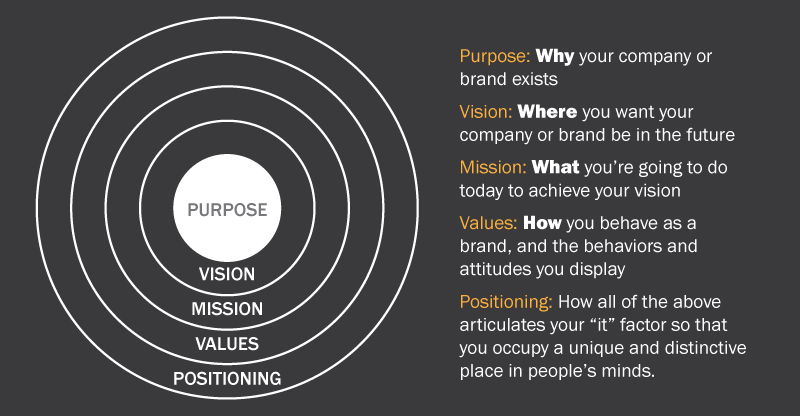Mission, vision, values, and positioning statements are the most widely recognized strategic tools used to define a company’s business, strategic objectives, and overall approach to reach those objectives. Another less frequently recognized strategic statement that many companies neglect to employ is the Purpose statement.
Your Purpose vs. Your Mission
A mission statement is often the lead-in to a company’s business or marketing plan. It provides a backdrop for everything the company does. It represents the enduring soul of the business and is both a rallying point for internal employees and a clear statement of intent for customers and the market as a whole.
Mission statements set the tone, stake out the territory, and guide all planning across the organization’s different functions. You can also think of it this way: A mission statement describes where you are today while a vision statement explains where you will be tomorrow.
The simplest definition of a purpose statement is “A higher-order reason for (a brand’s) existence that goes beyond making money and adds value to society.” Unlike your mission, your purpose is not something that will be achieved completely. As such, a purpose statement should give rise to an endless series of new goals, and always push you and your team forward.
In the legal filing of a new company, the purpose can be broadly defined as any lawful purpose for which companies may be organized. However, in a business plan, it is often best for the purpose to be narrow and focused to a tiny, vertical, niche market. For a small company, anything broader can cause the company to spread its efforts too thinly, and thereby never succeed in any market. In fact, a broad mission statement should be considered a red flag, warning you about the potential viability of the company (whether it be your own or one you will invest in).
Examples of Purpose Statements
For inspiration, here are some excellent examples of purpose statements:
- Google: “To organize the world’s information”
- Netflix: “To entertain the world”
- Apple’s purpose statement from the Steve Jobs era is “At Apple, we create tools for the mind that advance humankind” but it has since been updated to read “To empower creative exploration and self-expression”.
- Adidas’ is “Through sport, we have the power to change lives”.
- For HP, it’s “to foster the human capacity to innovate and progress”.
- Red bull: “”To give wings to people and ideas”
- Zappos: “”We deliver wow”
- REI: “To awaken a life-long love of the outdoors.”
Relationship to Brand Positioning
Many businesses mistake vision for mission and don’t know how all of these statements build upon each other. In the following graphic, you’ll see how vision, mission, values, and positioning all radiate from the core of purpose.

Your Brand Needs a Purpose
Having a clear and compelling purpose is increasingly essential and demanded of any company or brand seeking to attract talent, inspire its community, and out-innovate it’s competition. A purpose can act as “true north” for a brand, a guide that allows everyone in the company – from top to bottom – to understand what they are all there to accomplish. It’s the DNA at the core of your business.
As described in Accenture’s 2018 report, From me to we: The rise of the purpose-led brand, “..a company’s purpose, or lack of one, is an important driver of consumer behavior—and revenue. Purpose, which influences many consumers’ decisions to switch or keep spending with current brands, puts an estimated US$5 trillion of revenue at play globally. That’s an opportunity—and risk—too great for companies to ignore.”
Millennials and Generation Z now outnumber all other generations combined, globally. They are also more sensitive to how companies show clarity of purpose than other consumers. And they are more likely to reward those that get it right. According to the Accenture report, more than half of this audience has shifted a portion of their spending away from companies that disappointed them with their words or actions on a social issue.
Winning companies bring clarity to what they value, stand up for what they believe in, and apply purpose-led innovation to all parts of their organizations. In so doing, they attract consumers not just by the strength of their brands but also by their convictions.




